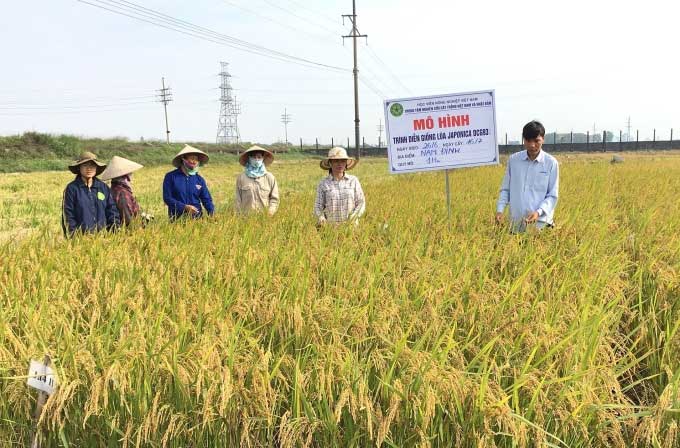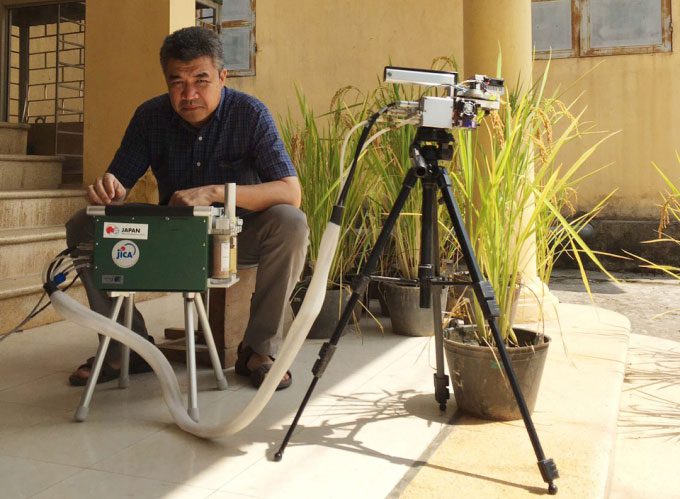Prof. Dr. Pham Van Cuong and his team have developed a new rice variety with a bran oil content of up to 20%, suitable for cooking oil production.
Rice bran oil is easy to produce and cost-effective, making it a popular food choice due to its high content of essential fatty acids and antioxidant compounds, especially gamma-oryzanol. In Vietnam, while there is a large production of rice and rice bran, rice bran oil is not yet widely used. In contrast, Japan has successfully developed rice varieties for high-quality rice bran oil production and is one of the largest producers and consumers of rice bran oil worldwide.
To develop promising new rice varieties for rice bran oil extraction in Vietnam, in 2019, the Ministry of Science and Technology launched a multi-faceted bilateral program to exchange genetic resources and breed japonica rice varieties for rice bran oil processing. The Vietnamese National Agricultural Institute is leading this initiative in collaboration with a group of scientists from the Faculty of Agriculture, Kyushu University, Japan.
Prof. Dr. Pham Van Cuong from the Vietnam-Japan Crop Research Center at the National Agricultural Institute stated that analysis by the research group showed that the oil content in the bran of the new japonica rice variety is about 7% higher than that of conventional rice varieties in Vietnam (Khang Dan 18). The rice bran ratio is also approximately 6% higher, indicating that the oil yield will significantly surpass that of traditional rice varieties. The gamma-oryzanol content is also about 50% higher, resulting in better oil quality. Additionally, the japonica rice variety is cold-resistant, fertilizer-tolerant, resistant to lodging, and exhibits lower susceptibility to certain pests.

Experimental model of the DCG93 rice variety in Nam Dinh. (Photo: NVCC)
Using molecular and genetic selection methods, the japonica rice line incorporates elite genes suitable for conditions in Vietnam. The first seeds have been multiplied over three seasons per year, including two Spring seasons and one Winter-Spring season in Hanoi, and one season in Soc Trang. “The new japonica rice variety DCG93 is suitable for oil extraction and yields high productivity in regions with strong sunlight, such as the northern mountainous provinces during Spring,” Prof. Cuong noted, reflecting on the results after over a year of implementation.
The growth duration of DCG93 rice in the northern provinces during the Spring season is 135-140 days, and 120-125 days during the Summer season. The plants are robust, resistant to lodging, exhibit low pest infection, and have average yields of 6.9 tons/ha in Spring and 5.7 tons/ha in Summer. DCG93 rice has high proportions (15.2-15.6% bran), (23.3-24.1% oil content in the bran), and (2.21-2.23% gamma-oryzanol). In comparison, the J02 japonica variety commonly grown in northern Vietnam has a bran ratio of 9.5-9.8%, an oil content of only 18.1-18.4%, and a gamma-oryzanol content of 1.37-1.41%.
According to Prof. Cuong, the project’s success lies in utilizing genetic materials and selection methods from Japan. The research team has established a japonica rice cultivation process tailored to the ecological conditions of rice-growing regions in Vietnam. Furthermore, the technology for extracting crude rice bran oil has been developed by the team, showing initial promising results in the laboratory, yielding high-quality oil.

Prof. Pham Van Cuong using a photosynthesis intensity measurement device in rice variety research. (Photo: NVCC)
For large-scale rice bran oil production, Prof. Cuong believes it is essential to integrate with raw material regions, potentially utilizing rice bran from milling conventional rice varieties. In addition to expanding the production scale of the japonica rice variety for oil extraction, research into processing and utilizing japonica rice products after milling for bran should be conducted to enhance the economic efficiency of rice cultivation.
Prof. Cuong further stated that the team will continue to develop the DCG93 japonica rice line and other promising rice varieties while improving the oil extraction and refining processes. “We hope to continue receiving support from the Ministry of Science and Technology, localities, and businesses so that the DCG93 rice variety can be recognized and scaled up for large-scale production, thereby enhancing economic value for farmers,” Prof. Cuong said.


















































